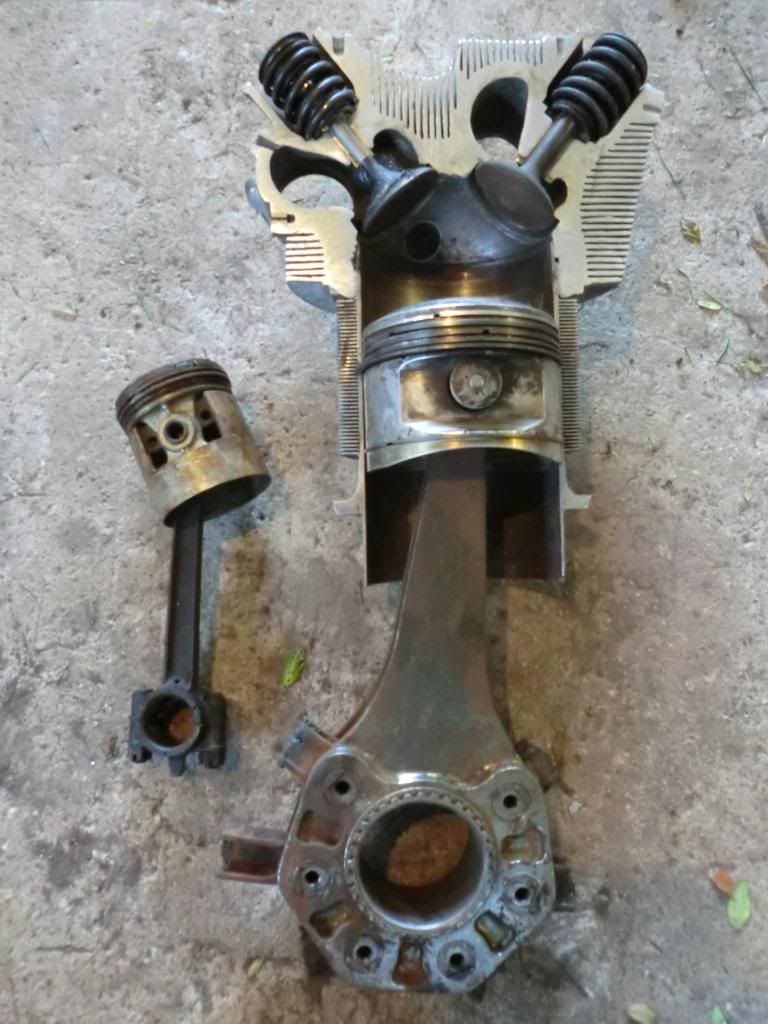Re: Village idiot tranforms a T28 Trojan fuselage into a car
Sat Mar 23, 2013 7:17 pm
A reciprocating saw, is not ordinarily, the first tool found at the top of an airplane mechanics toolbox 
What a fun project. Cool!
Thanks for keeping us posted. I love the wind chime. Especially 'cause it probably doesn't make noise. (I actually hate wind chimes)
I look forward to what happens next.
Andy Scott
What a fun project. Cool!
Thanks for keeping us posted. I love the wind chime. Especially 'cause it probably doesn't make noise. (I actually hate wind chimes)
I look forward to what happens next.

Andy Scott
Re: Village idiot tranforms a T28 Trojan fuselage into a car
Mon Apr 01, 2013 11:18 am
Re: Village idiot tranforms a T28 Trojan fuselage into a car
Mon Apr 01, 2013 11:50 am
Fully discussed, including by the builder/owner, on the previous page.
Re: Village idiot tranforms a T28 Trojan fuselage into a car
Wed May 15, 2013 4:43 pm
Well, I figured since I'm going to try and make this T28 look similar to an Avenger, then it should at least have the nose of an R2600 sticking out of it. I've had this massively corroded R2600 laying in front of a friend of mine's building for some time now. The property has been sold, so I had to move the engine out in a hurry. The easiest way to move a monster this heavy was to take it apart on site. I took a torch to the guts of the gear reduction unit and reduced a LOT of weight that way. The prop shaft still turns and I can now easily pick up the nose case. I used a 7" cut off wheel on my grinder to cut a cylinder in half. I could only go so deep before the a reciprocating saw had to take over. The only way to cut through the thick hardened stainless steel valve seats was with a plasma cutter. It took me about two hours to cut the cylinder in half. I now have the front half of a cylinder that will be bolted back on the engine, and the rear half will make a neat display piece. Only a few more cylinders to go! The old R1300 that came on this T28 will be just hung up in the shop for looks. I made a simple tool out of an old rocker arm in order to remove the valves. I didn't want to take a chance of cutting into one of the sodium filled valves(bang).
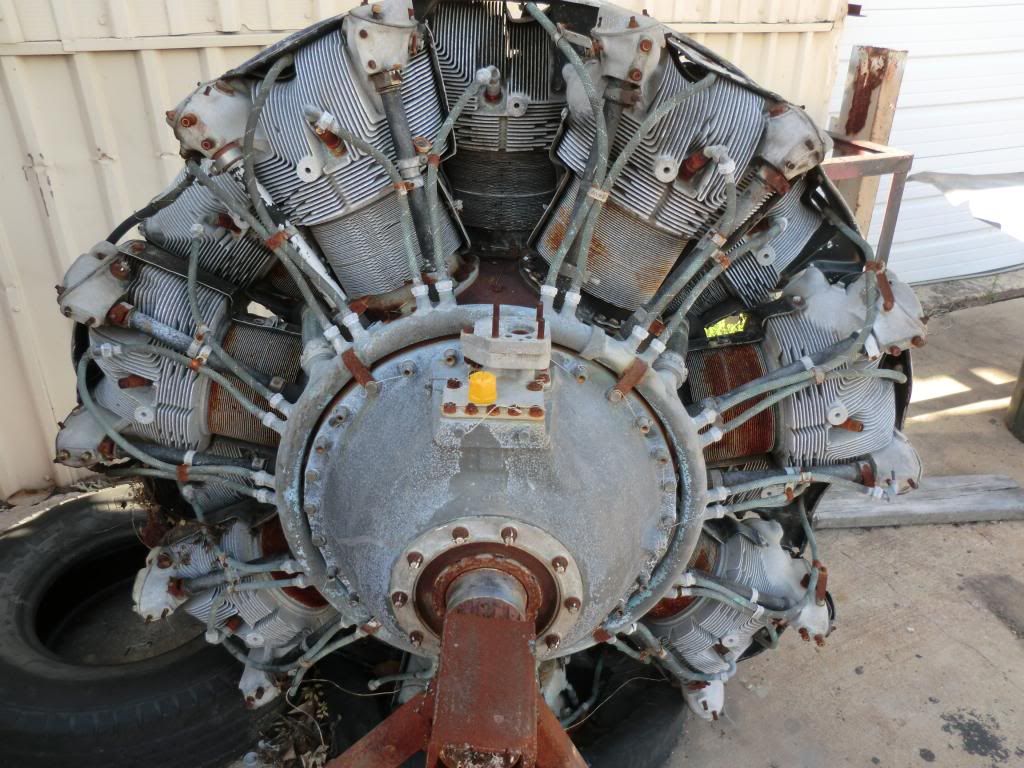



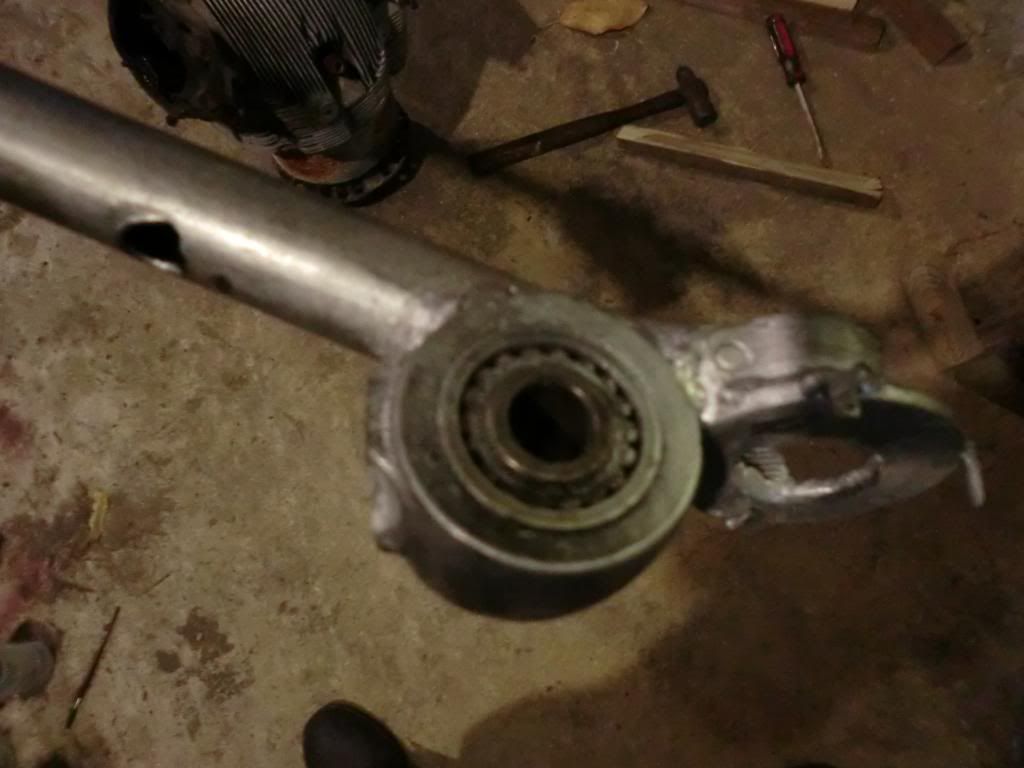
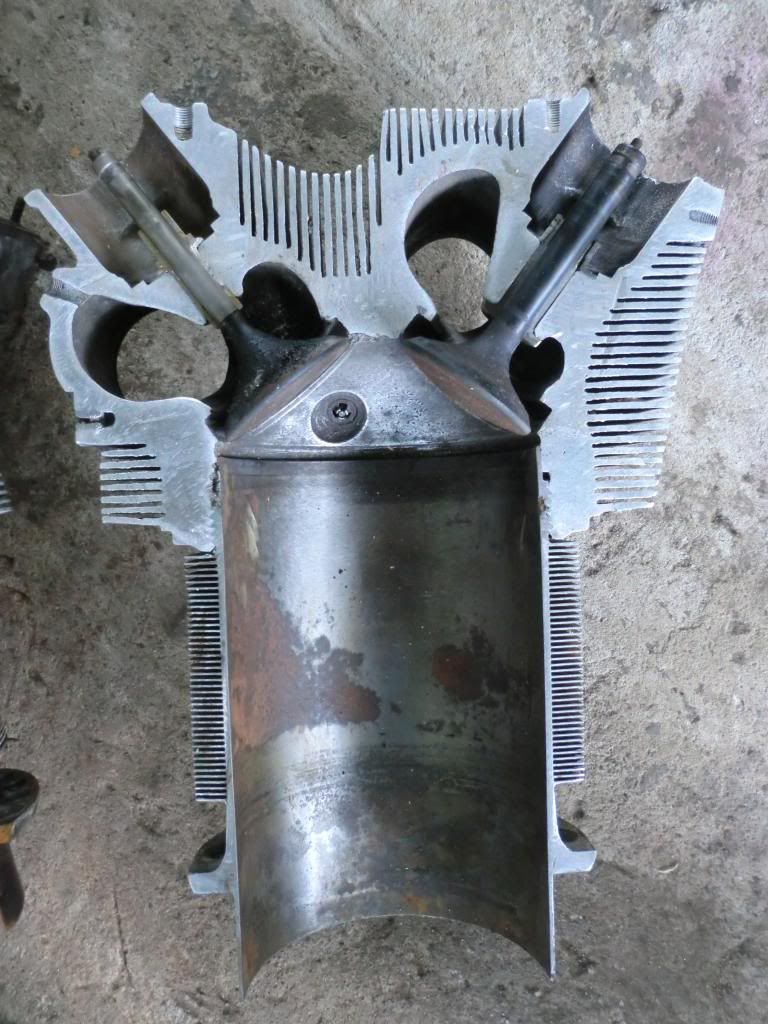
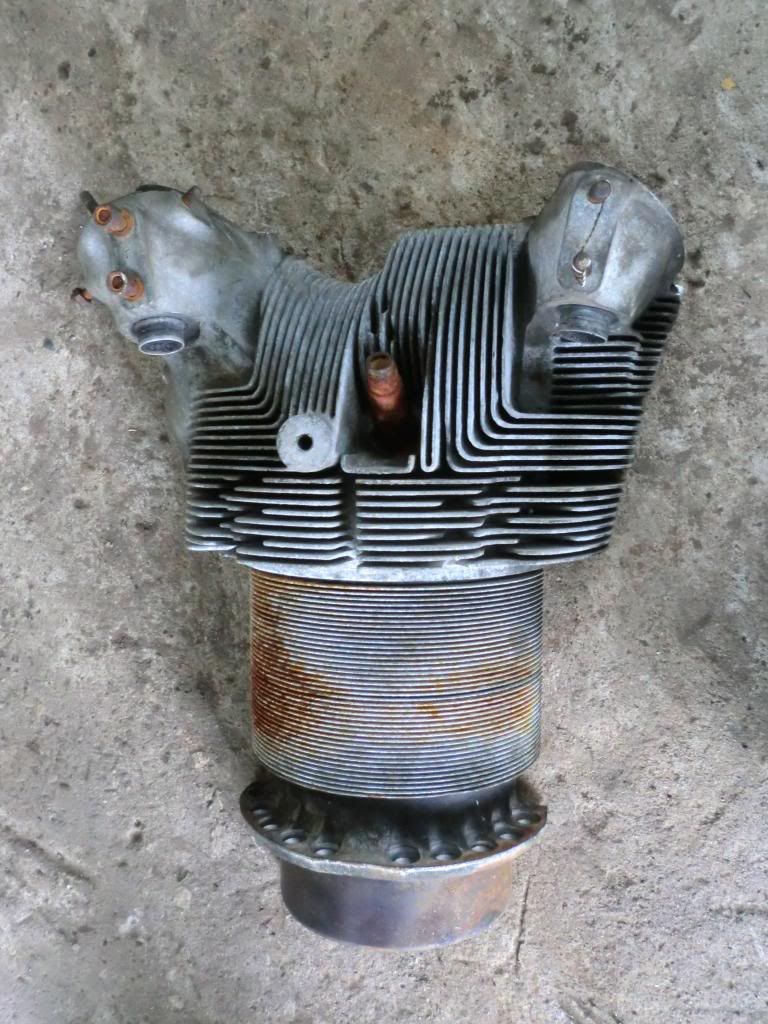







Re: Village idiot tranforms a T28 Trojan fuselage into a car
Thu May 16, 2013 9:33 pm
Does anyone recall a guy doing this with a DC-3 fuselage and a school bus? Perhaps very late 70s?
Re: Village idiot tranforms a T28 Trojan fuselage into a car
Thu May 16, 2013 10:26 pm
Like this?


Re: Village idiot tranforms a T28 Trojan fuselage into a car
Thu May 16, 2013 10:35 pm
I've been collecting images like this in hopes of someday doing an article on airplanes converted into buses, restaurants, gas stations, billboards, hotels, discos and darn near anything else you can think of. There must be a dozen DC-3 buses out there...
Re: Village idiot tranforms a T28 Trojan fuselage into a car
Sat May 18, 2013 8:25 pm
I was finally able to completely disassemble the Wright R2600 today. I figured I had about 1500lbs in the bed of the truck. Of the 14 cylinders, only three came off naturally. All the others had to have the connecting rods cut with a torch because the pistons are so badly corroded to the cylinder walls. What a pain in the butt. Now I will try soaking the cylinder walls with transmission fluid to hopefully free up the pistons so that the cylinders can be taken apart and eventually cut in half.


Re: Village idiot tranforms a T28 Trojan fuselage into a car
Sun May 19, 2013 2:59 am
Now I will try soaking the cylinder walls with transmission fluid to hopefully free up the pistons so that the cylinders can be taken apart and eventually cut in half.
Try the new improved formula posted on the H.A.M.B. - 50/50 trans fluid and acetone. If you do, let us know how well it works and I bet it would be helpful to a lot of WIXers as well.
Re: Village idiot tranforms a T28 Trojan fuselage into a car
Sun May 19, 2013 7:30 am
Ive pulled apart a few stuck radials. I make a fitting for my grease gun (I have a air operated one) that goes into the spark plug hole and hooks up to the gun. get a non fouler plug adapter from any auto parts store and fit it to the spark plug hole.. leave the other plug in the head and make sure the valves are closed. pump away and off the cylinders come. easy but a little messy.
Re: Village idiot tranforms a T28 Trojan fuselage into a car
Sun May 19, 2013 8:45 am
You may want to try PB Blaster. It stinks to high heaven, but it works. It's unstuck plenty of frozen and cold welded bicycle parts in my garage.
Re: Village idiot tranforms a T28 Trojan fuselage into a car
Sun May 19, 2013 10:14 am
FTW Diet Coke can be effective (and cheeeeeap). Coke contains phosphoric and citric acids. Phosphoric acid is one of the main ingredients in naval jelly and lots of other rust treating formulas, and citric acid converts rust to ferric citrate, which is the only water-soluble form of iron (why vitamin C is good for you). Diet because it dosen't have sugar to gum anything up.
Re: Village idiot tranforms a T28 Trojan fuselage into a car
Sun May 19, 2013 3:01 pm
shrike wrote:FTW Diet Coke can be effective (and cheeeeeap). Coke contains phosphoric and citric acids. Phosphoric acid is one of the main ingredients in naval jelly and lots of other rust treating formulas, and citric acid converts rust to ferric citrate, which is the only water-soluble form of iron (why vitamin C is good for you). Diet because it dosen't have sugar to gum anything up.
I think I'll give it a try. Since I have several equally rusted solid cylinders, I'll probably give the acetone and transmission fluid idea a try too. along the lines of the grease gun idea, I'm thinking of taking a high pressure power washer and making an adapter to connect to the spark plug hole. 2500lbs/sq.in of water would hopefully do it too. Now to start the great experiments!
Jason
Re: Village idiot tranforms a T28 Trojan fuselage into a car
Sun May 19, 2013 7:06 pm
Ok, I filled three of the chunkiest, most heavily corroded cylinders with Diet Coke. I figure the phosphoric acid might actually creep down in and dissolve some of the swollen and powdery piston corrosion. I sprayed two cylinders with PB Blaster around the edge of the piston and tried to get as much as possible into the tiny oil weep holes on the inside of the piston around the rings. The other jugs I sprayed half automatic transmission fluid and acetone around the skirt of the piston repeatedly allowing a bit of time for the solution to creep down between doses. I then poured transmission fluid, power steering fluid and acetone into each piston until level with the skirt. The acetone hopefully thinned the trans. fluid long enough for it to get to the rings before the acetone evaporated. Acetone evaporates at an alarming rate.
I had hit the ends of each rod pretty hard with a 10lb sledge hammer this morning and not one of them even thought about moving. After about 2 hours of the jugs "cooking" in the solutions, I hit each rod again. This time two of the pistons moved up the jug slightly. One of them has freed up entirely, but the suction from the valve won't allow me to just pull it out. I'll wait until tomorrow, depress one of the valves with my homemade valve tool and the pistons should just slide out.
Also, the rods must have been made of some fairly hard steel, because every time I hit one the ends would shatter like glass. No, it wasn't the slag from when they were cut with a torch either. One of the shards did a number on my hand, so about a gallon of blood is in one of the cylinders. We'll see if that will help to free up those pistons.
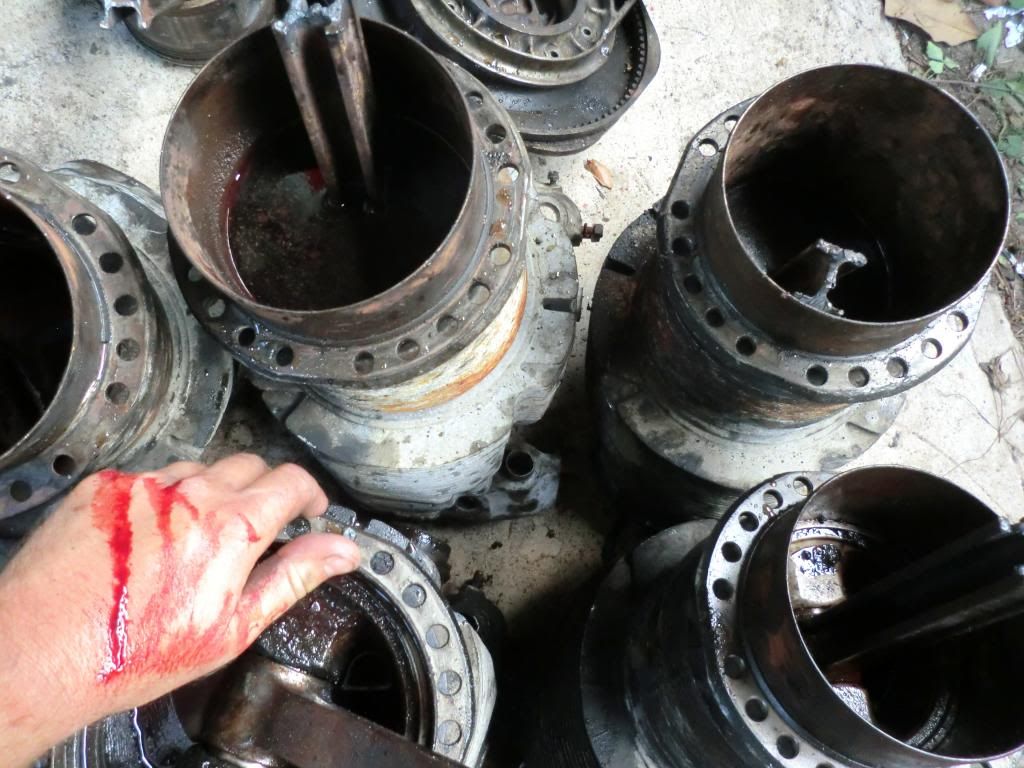
I had hit the ends of each rod pretty hard with a 10lb sledge hammer this morning and not one of them even thought about moving. After about 2 hours of the jugs "cooking" in the solutions, I hit each rod again. This time two of the pistons moved up the jug slightly. One of them has freed up entirely, but the suction from the valve won't allow me to just pull it out. I'll wait until tomorrow, depress one of the valves with my homemade valve tool and the pistons should just slide out.
Also, the rods must have been made of some fairly hard steel, because every time I hit one the ends would shatter like glass. No, it wasn't the slag from when they were cut with a torch either. One of the shards did a number on my hand, so about a gallon of blood is in one of the cylinders. We'll see if that will help to free up those pistons.

Re: Village idiot tranforms a T28 Trojan fuselage into a car
Sun May 19, 2013 8:05 pm
